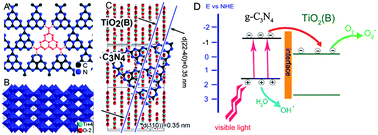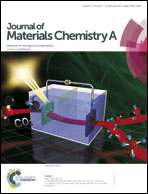Heterojunctions in g-C3N4/TiO2(B) nanofibres with exposed (001) plane and enhanced visible-light photoactivity†
Abstract
The formation of heterojunctions is an efficient strategy to extend the light response range of TiO2-based catalysts to the visible light region. In addition to the bandgap edge match between the narrow bandgap semiconductors and the TiO2 substrate, a stable phase interface between the sensitiser and TiO2 is crucial for the construction of heterojunctions, since it acts as a tunnel for the efficient transfer of photogenerated charges. Herein, the coincidence site density (1/Σ) of graphite-like carbon nitride (g-C3N4) nanoflakes and two types of TiO2 nanofibres [anatase and TiO2(B)] was calculated by near coincidence site lattice (NCSL) theory. It was found that the coincidence site density of g-C3N4 and TiO2(B) nanofibre with an exposed (001) plane is 3 times of that of the g-C3N4 and anatase nanofibre with exposed (100) plane. This indicated that the g-C3N4 nanoflakes are more favoured to form stable heterojunctions with TiO2(B) nanofibres. As expected, a stable phase interface was formed between the plane of (22–40) of g-C3N4 and the plane (110) of TiO2(B) which had same d-spacing of 0.35 nm and the same orientation. Under visible light irradiation, the photogenerated electrons could efficiently migrate to the TiO2(B) nanofibres from the g-C3N4 through the heterojunctions. So the g-C3N4/TiO2(B) system exhibited better photodegradation ability for sulforhodamine B (SRB) dye than the g-C3N4/anatase system, although the photoactivity of the anatase nanofibres was much better than that of the TiO2(B) nanofibres.


 Please wait while we load your content...
Please wait while we load your content...